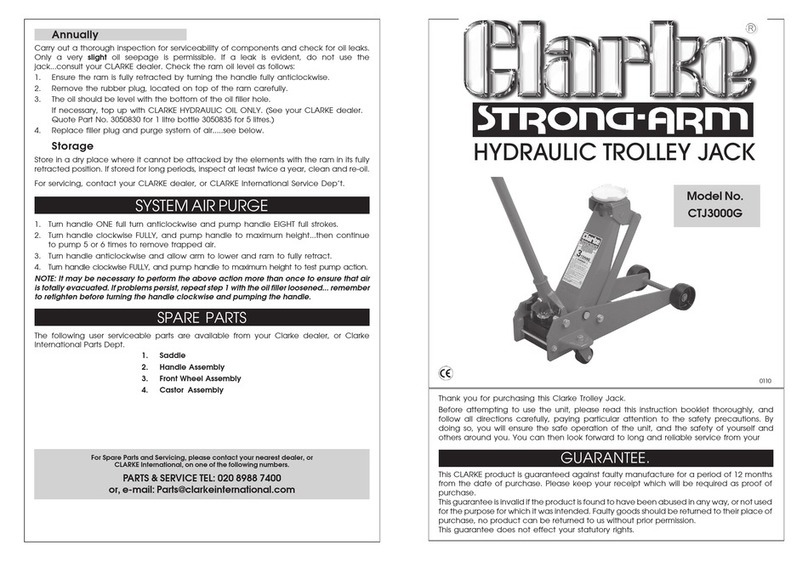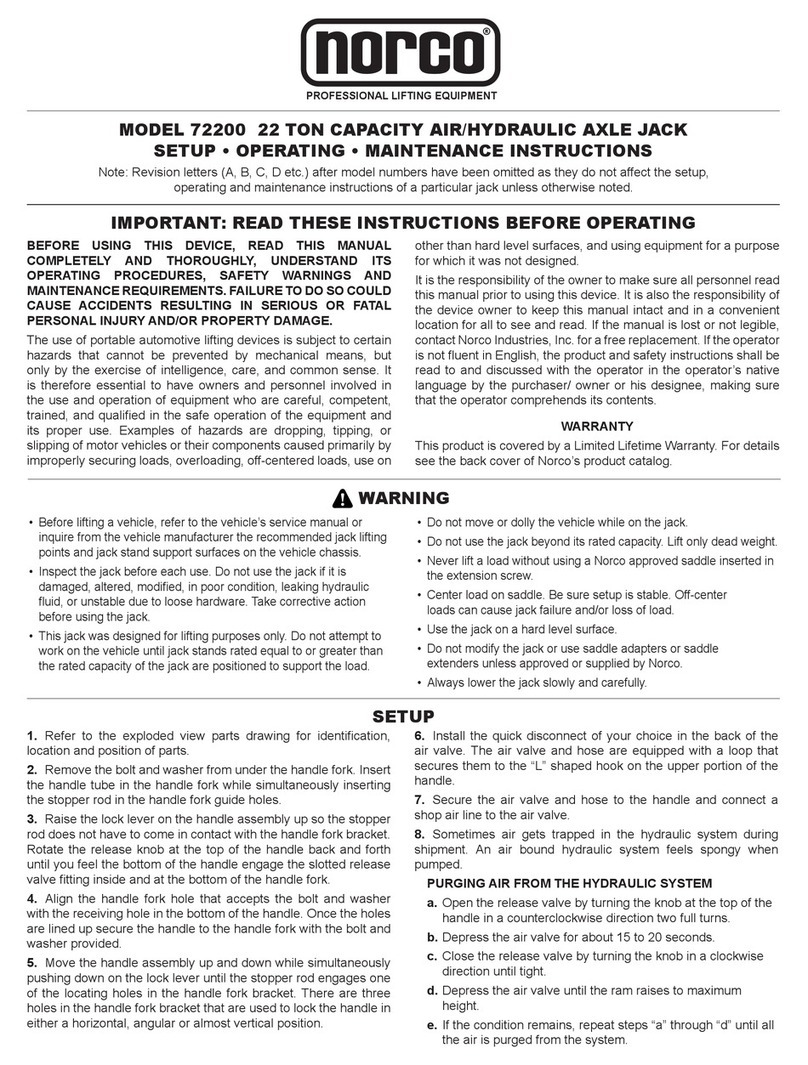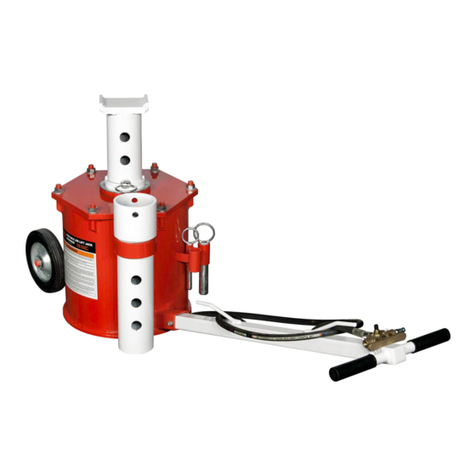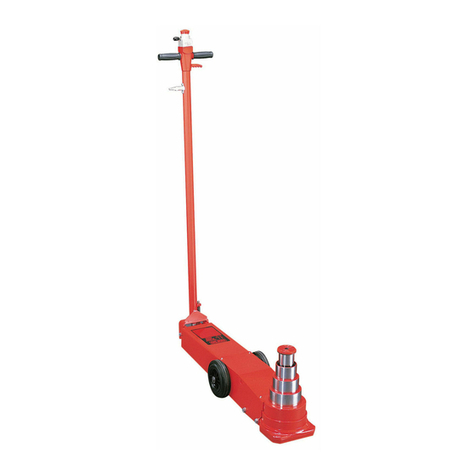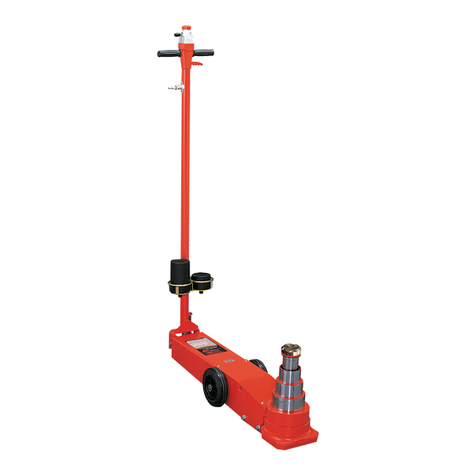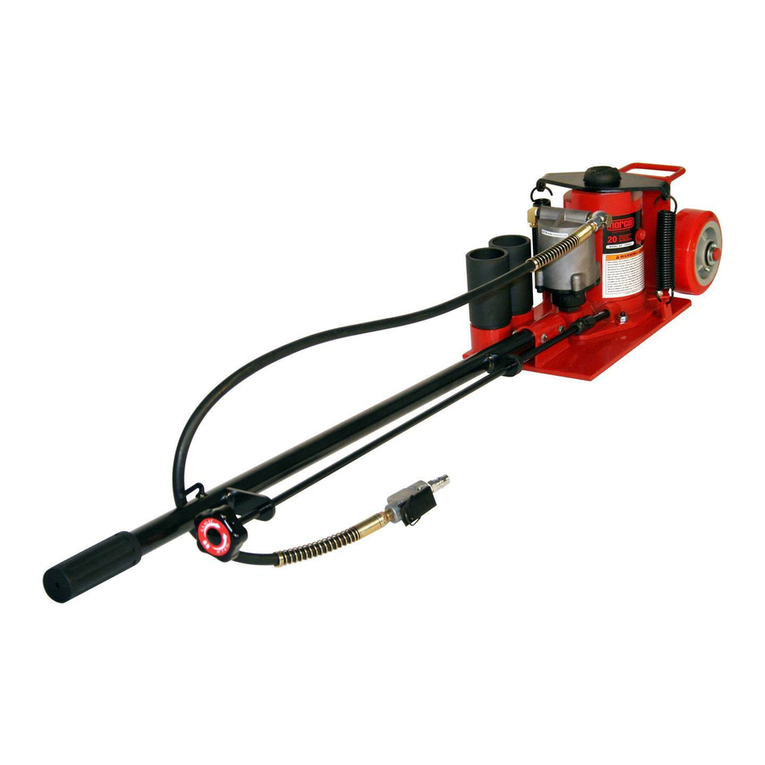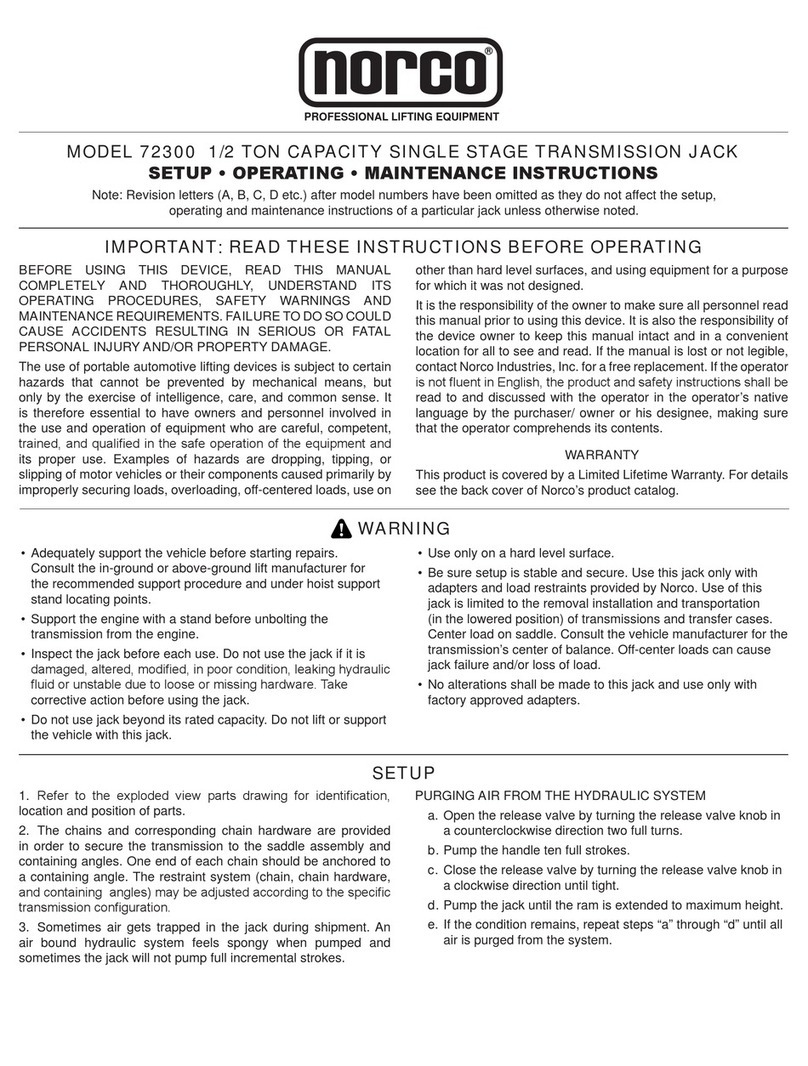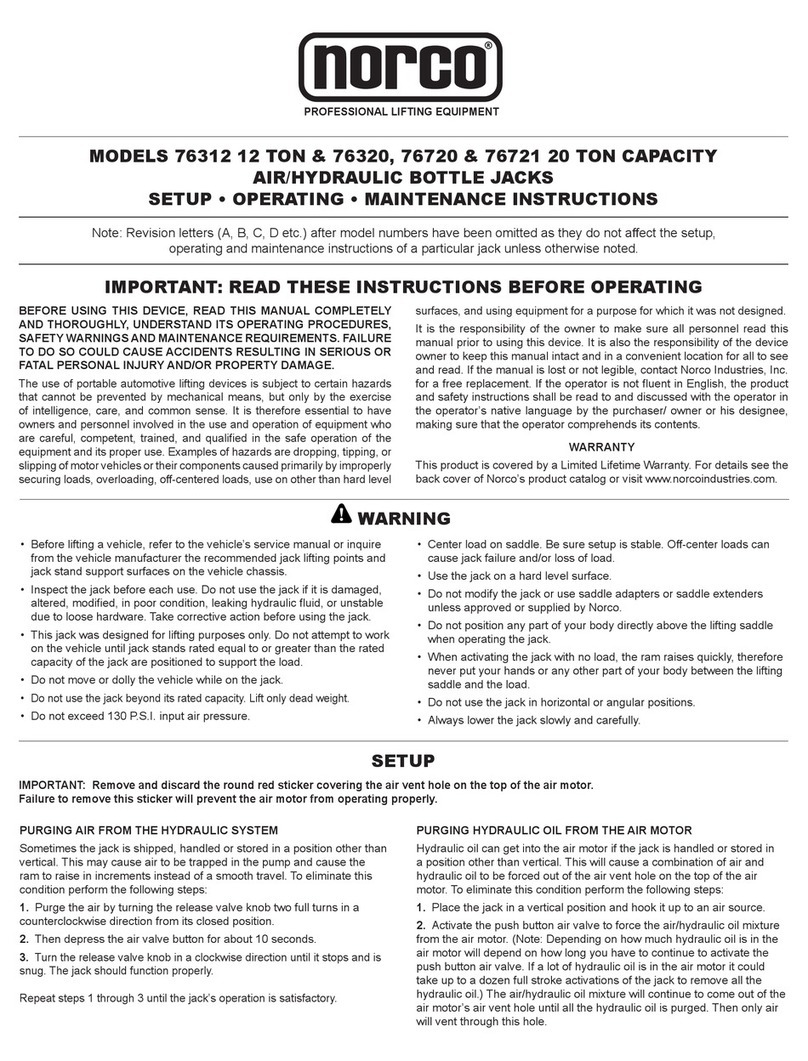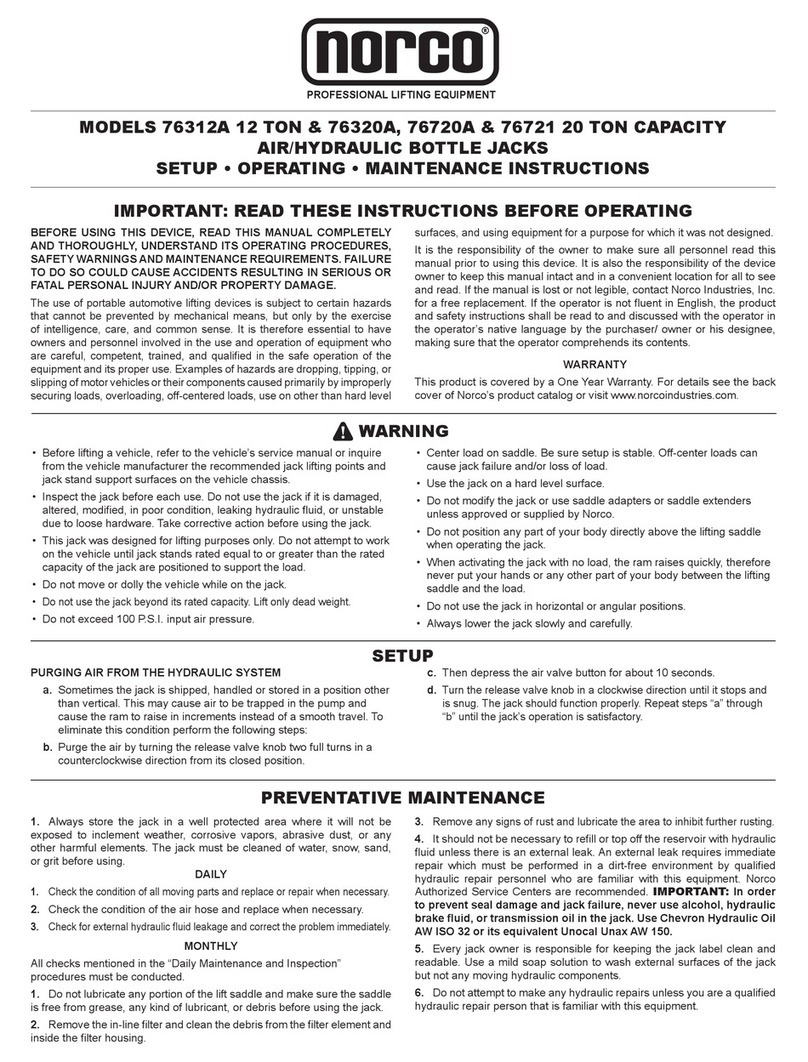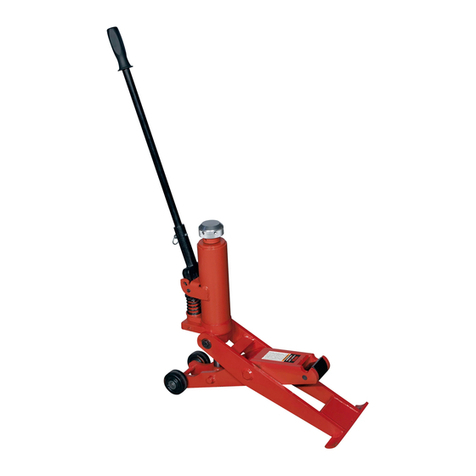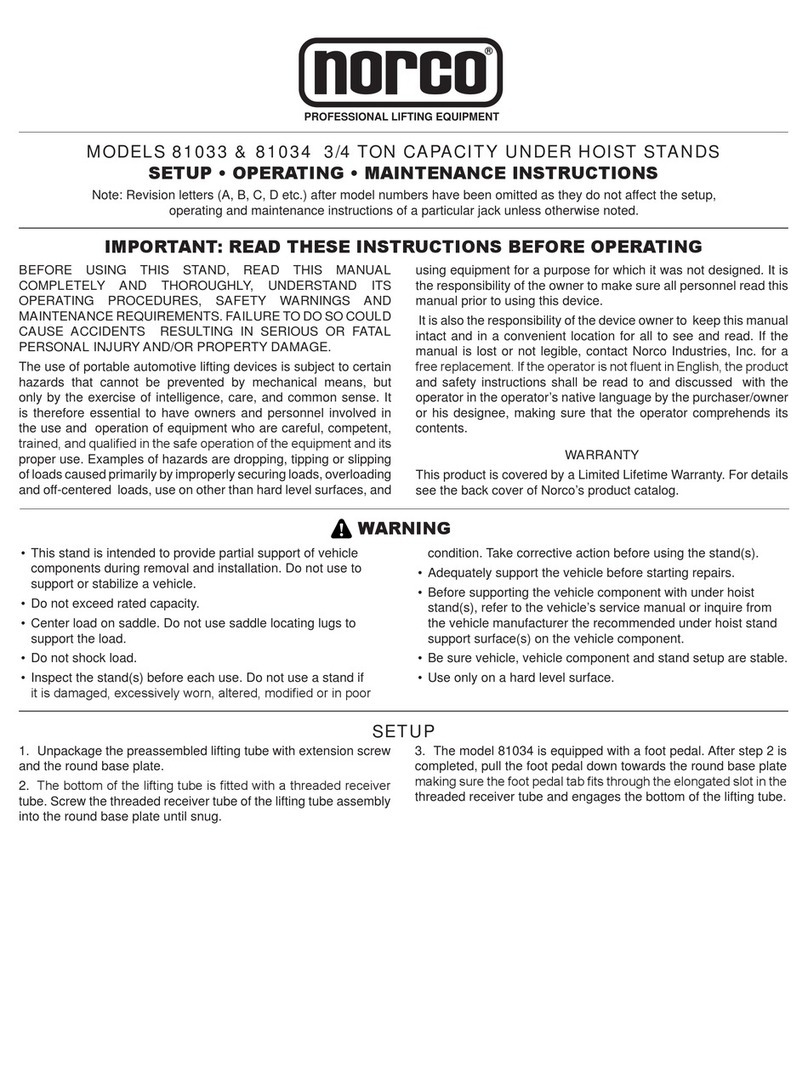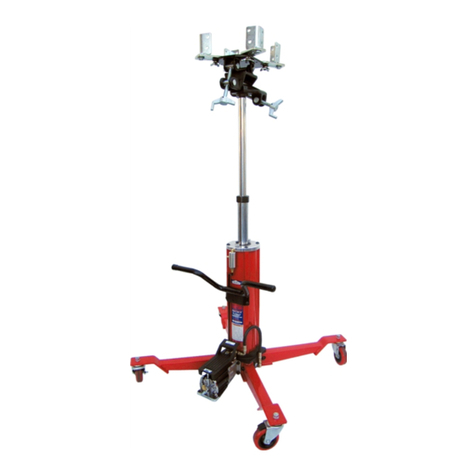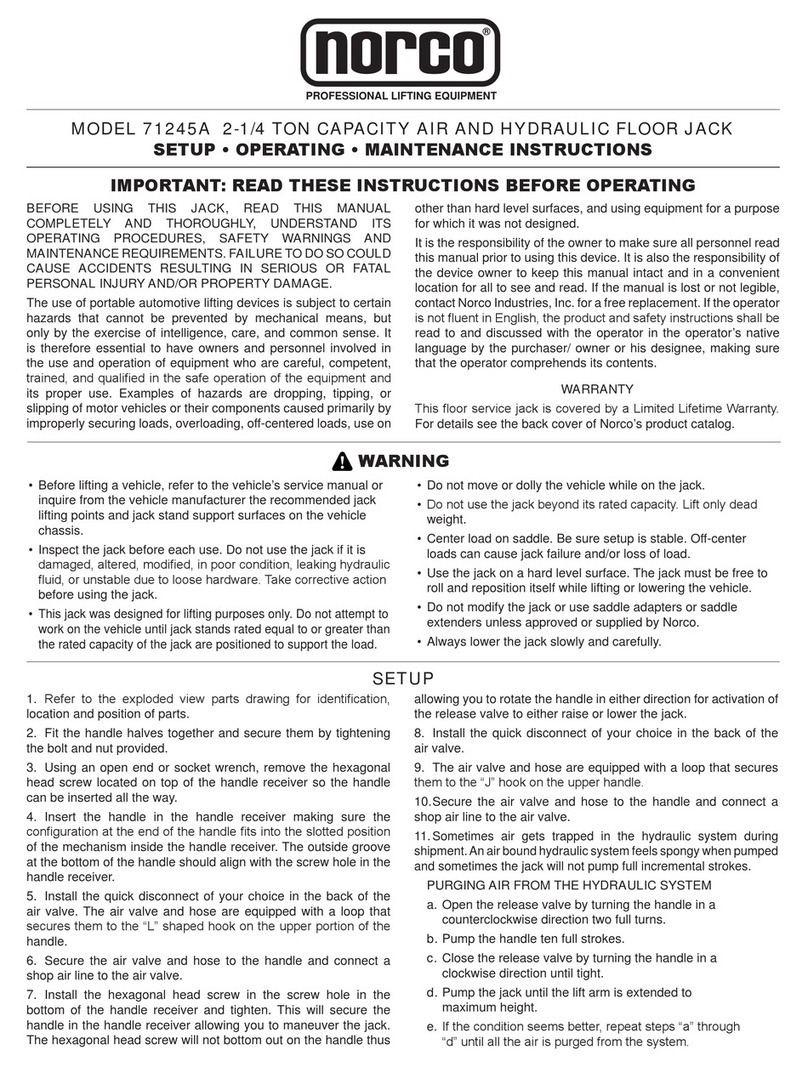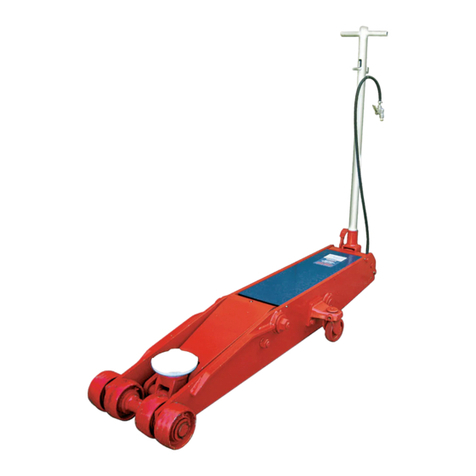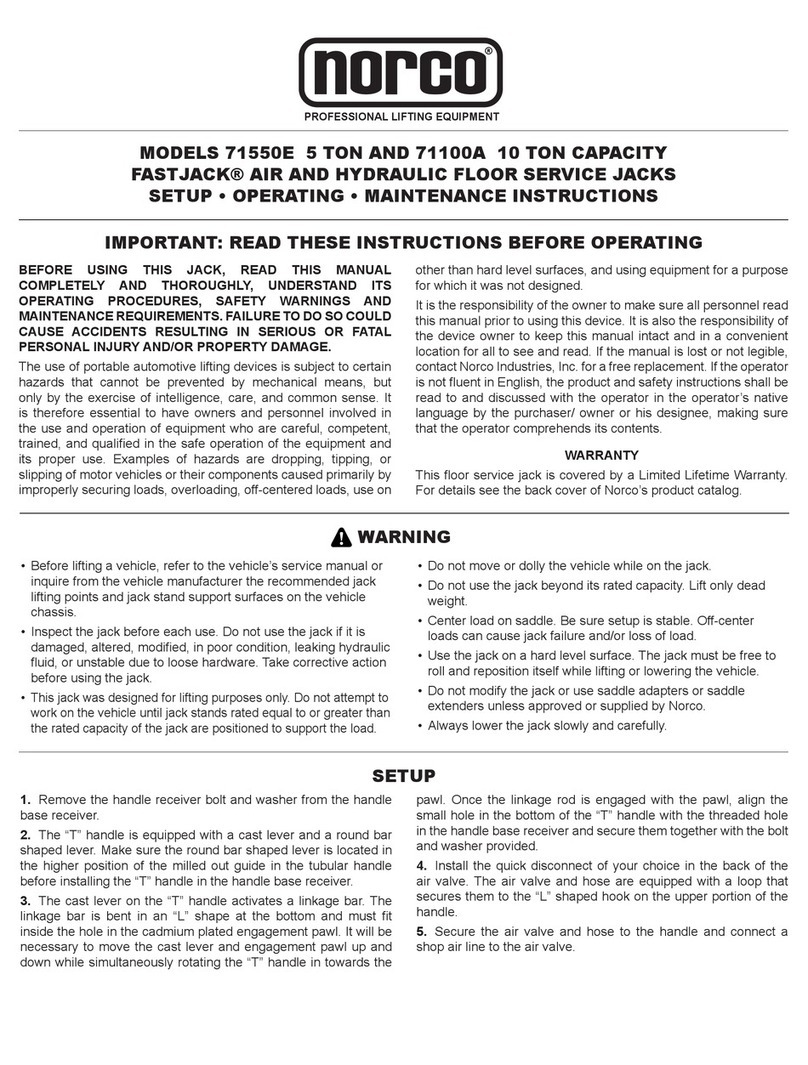
OPERATING INSTRUCTIONS
CAUTION For Your Safety: This jack was designed for jacking purposes
only. After jacking always use safety stands to support the load before
making repairs.
1. Chock the vehicle’s tires that will not be lifted off the ground prior to lifting
the vehicle and if available, apply the emergency brake or any other method
of braking.
2. The air motor is designed to work at maximum efciency between 85 and
100 p.s.i. system air pressure. It will be necessary to have between 85 and
100 p.s.i. air pressure at the pump in order for the jack to lift its maximum
capacity. DON’T use the air hose (#19) to pull the weight of the jack as
it may cause damage to the ttings and/or air hose. DON’T
neglect the
components, ttings, adapters, and hoses by rough handling of the jack.
CAUTION For Your Safety: Use jack on hard level surface, center the load
on the saddle and make sure the setup is stable. Poor operator judgement
and/or unstable setup could cause load to slip off the jack saddle and cause
personal injury and/or property damage.
3. Position the jack under the load and determine how much stroke is
required to lift the load to the required height. Any ram stroke used to raise
the extension screw saddle to the load reduces your lift stroke. The extension
screw saddle and adapters (#11) are used to make up the distance between
the saddle and the load so that you will have the most available hydraulic ram
stroke. DON’T use the ram and/or extension adapters (#11) without the
extension screw saddle as this could cause damage to the counterbore
of the ram and adapters (#11).
4. Close the release valve knob (#6) by turning it in a clockwise direction
until it stops and is snug. IMPORTANT: Use the vehicle manufacturer’s
recommended lifting procedures and lifting points before lifting loads.
5. Depress the air valve button to raise the saddle to the load. Before lifting
the load make sure the saddle is centered on the load and the setup appears
stable. If not, reposition the jack and saddle contact with the load until the
setup is stable. DON’T use the jack in unstable setup conditions as the
load could slip off the saddle and cause damage to jack components.
DON’T use the entire base assembly (#2) as a load bearing surface. The
only intended load bearing surface is directly under the hydraulic jack.
Using the entire base assembly (#2) to support the load could cause a
bent, broken or deformed base (#2) and other related jack components.
DON’T use front wheels (#8) for load bearing purposes. They are only
designed to transport and position the jack.
6. Depress the air valve button to lift the load to the desired height. During
lifting, inspect the position of the jack in relationship to the ground and the ram
in relation to the load to prevent any unstable conditions from developing. If
conditions look like they are becoming unstable, slowly lower the load and
make the appropriate setup corrections after the load is fully lowered.
7. When the vehicle or load is lifted to its desired height, immediately place
safety support stands (jack stands) in their designated locations and adjust
the stands’ support columns up as close to the designated vehicle support
points as possible. Although jack stands are individually rated, they are to be
used in a matched pair to support one end of a vehicle only. Stands are not to
be used to simultaneously support both ends or one side of a vehicle. Slowly
and carefully turn the release knob in a counterclockwise direction to gently
lower the vehicle onto the safety support stands (jack stands). Make sure
the vehicle is safely supported by the safety support stands’ (jack stands’)
saddles and not the locating lugs of the saddles. Inspect the relationship
of the safety support stands (jack stands) with the ground and the safety
support stand (jack stand) columns and saddles with the vehicle to prevent
any unstable conditions. If conditions look unstable, close the jack’s release
knob and depress the air valve to raise the vehicle off the safety support
stands (jack stands). Make the appropriate setup changes and slowly and
carefully lower the vehicle onto the safety support stand saddles. DON’T
use the jack handle assembly (#4) for purposes other than transporting or
positioning the jack. DON’T use the handle assembly (#4) as a prybar to
dislodge the jack.
8. After the work is done, close the release knob and depress the air valve
until the jack is high enough to remove the vehicle or load from the safety
support stand saddles. Be sure load is stable. If it is not, lower load back onto
safety support stands. Make appropriate setup corrections and repeat the
step again. Remove the safety support stands from under the vehicle being
very careful not to move the vehicle.
9. Turn the release knob in a counterclockwise direction very slowly and
carefully to lower the vehicle or load down to the ground. The jack may be
stored in its normal use position or in a vertical position in order to save
space. DON’T use or store the jack with the handle assembly (#4) end
of the jack pointing or angling down. Loss of uid could render the jack
inoperable. NOTE: The jack is designed with an additional air line that adds
pressure to the oil in the reservoir and forces the oil into the hydraulic pump.
The air line is vented by way of a hole located in the 1/8 NPT 90° elbow tting.
Oil from the reservoir can seep out of the hole if the jack is used or stored with
the handle assembly (#4) end of the jack pointing or angling down. Excessive
leaking from this hole could reduce the required oil level in the reservoir and
render the jack inoperable. Slight or occasional leakage from this hole should
not cause any concerns.
IMPORTANT: The oil ll level should be no higher than one inch
below the air inlet on the oil reservoir when the ram is completely
retracted. Use hydraulic jack oil or turbine oil only.
REPAIR SERVICE
If your Norco product requires service or repair, contact the Norco Customer
Service Department for the location of the nearest Norco Authorized
Service Center.
Norco Industries, Inc.
365 West Victoria St.
Compton, CA 90220
(310) 639-4000 • Fax: (310) 639-7411
www.norcoindustries.com
It will be necessary to provide the Norco Authorized Service Center with
a copy of the bill of sale if requesting warranty repair. If the authorized
service center determines your product is eligible for warranty repair, the
repair will be made at no charge and returned freight prepaid. The cost
of non-warrantable service, repair, and return freight is the customer’s
responsibility.
1. Always store the jack in a well protected area where it will not be
exposed to inclement weather, corrosive vapors, abrasive dust, or any
other harmful elements. The jack must be cleaned of water, snow, sand,
or grit before using.
DAILY
1. Check the condition of all moving parts and replace or repair when necessary.
2. Check the condition of the air hose and replace when necessary.
3. Check for external hydraulic uid leakage and correct the problem immediately.
MONTHLY
All checks mentioned in the “Daily Maintenance and Inspection”
procedures must be conducted.
1. Check and lightly grease the universal joint, the counter-bores of the
ram and 4” extension adapters, the telescopic ends of the 4” extension
adapters, the saddle extension screw threads and the axle. Do not lubricate
any portion of the lift saddle and make sure the saddle is free from grease,
any kind of lubricant, or debris before using the jack.
2. Remove the in-line lter and clean the debris from the lter element and
inside the lter housing.
3. Remove any signs of rust and lubricate the area to inhibit further rusting.
4. It should not be necessary to rell or top off the reservoir with hydraulic
uid unless there is an external leak. An external leak requires immediate
repair which must be performed in a dirt-free environment by qualied
hydraulic repair personnel who are familiar with this equipment. Norco
Authorized Service Centers are recommended. IMPORTANT: In order
to prevent seal damage and jack failure, never use alcohol, hydraulic
brake uid, or transmission oil in the jack. Use Chevron Hydraulic Oil
AW ISO 32 or its equivalent Unocal Unax AW 150.
5. Every jack owner is responsible for keeping the jack label clean and
readable. Use a mild soap solution to wash external surfaces of the jack
but not any moving hydraulic components.
6. Do not attempt to make any hydraulic repairs unless you are a qualied
hydraulic repair person that is familiar with this equipment.
PREVENTATIVE MAINTENANCE
72080 / 72090


